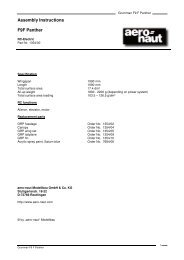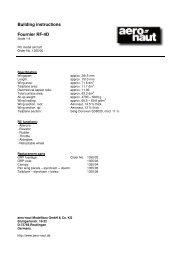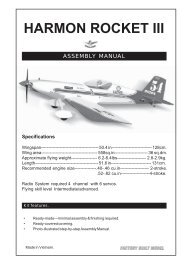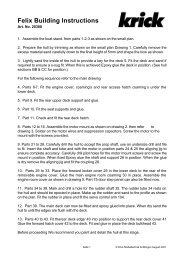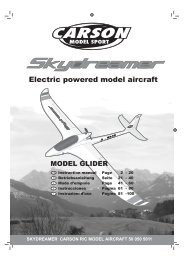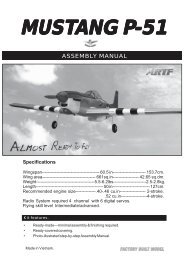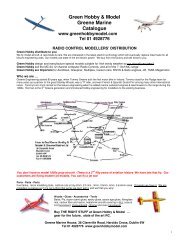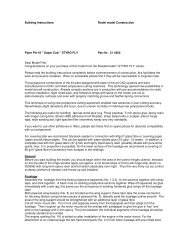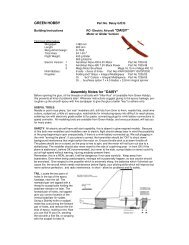Building instructions Pober Pixie - aero-naut Modellbau
Building instructions Pober Pixie - aero-naut Modellbau
Building instructions Pober Pixie - aero-naut Modellbau
Create successful ePaper yourself
Turn your PDF publications into a flip-book with our unique Google optimized e-Paper software.
<strong>Pober</strong> <strong>Pixie</strong><br />
• Slit and peel off a strip of film about 10 - 15 mm wide in the centre of the top surface in the same<br />
manner (for attaching the fin and strake).<br />
• Cyano glue can also be applied directly to the film. In this case it is important to sand the joint line<br />
carefully and to apply the glue very accurately, because cyano behaves differently to epoxy, and<br />
the glued joint may fail after a shock.<br />
• Carefully replace the tailplane on the fuselage and epoxy the parts together.<br />
Vertical stabiliser - fin and rudder<br />
• The fin and strake are made of balsa and sanded. They are prepared for installation, including<br />
two slots for hinges. The strake consists of two parts.<br />
• Offer up the strake to the tailplane (attached to the fuselage) and sand it to fit accurately. Glue the<br />
strake to the fin. Sand this assembly smooth, taking care to shape the leading edge as shown.<br />
• Check that the assembly fits neatly on the fuselage, then cover the fin and strake with film.<br />
• Be sure to leave a strip of bare wood about 5 mm wide at the bottom of the fin on both sides.<br />
• Glue the covered fin assembly in place, taking care to set it exactly vertical relative to the<br />
tailplane, and in line with the fuselage centreline.<br />
• Cut the 8 x 8 mm triangular bracing strips to length (DET. 6) and trim them to fit. Cover the<br />
outside surface of the strips, and glue them in the joints between the tailplane and the fin.<br />
• Attach the hinges to the fin and tailplane and prepare the recess for the steerable tailwheel<br />
control rod.<br />
Installing the servos and “snakes”<br />
• Cut out the openings in the servo plate (plywood part #6) to match the actual size of your servos.<br />
• Prepare the servo plate for installation in the fuselage as shown in the drawing (DET. 7).<br />
• Sand the servo plate and trim it to fit in the fuselage. Glue the spruce strips on the underside and<br />
trim this assembly to fit in the fuselage. Apply epoxy to the hardwood strips and glue the servo<br />
plate in the fuselage.<br />
• Preparing the linkages: these are based on the 8 x 8 mm balsa pushrods supplied. Attach an M2<br />
metal clevis to one end - see drawing (DET. 8): bend the final 5 mm of the metal rod at 90°, push<br />
the angled end into the balsa pushrod, wrap thread round it and secure the joint with cyano or<br />
white glue. Cut the pushrod to the required length to suit the exact position of the servo and the<br />
control surface hinge line, then attach a metal clevis to the other end.<br />
• Cut the pushrod exit slots in the tail end of the fuselage - to avoid unnecessary slop in the control<br />
system, the run of the pushrod should be as straight as possible, and the metal rod should be<br />
bent as little as possible. We recommend that you provide support for the pushrod across the<br />
fuselage as shown in the drawing. This is necessary because the exit slots in the fuselage for the<br />
elevator and rudder pushrods must be at different levels to avoid the pushrods fouling each other.<br />
Tip: this task is much easier if you cut an access opening in the tailplane support surface.<br />
• The pushrods must be installed in such a way that lost motion (play) in the control system is<br />
minimised, that the fore-and-aft travel of the pushrod is unrestricted, that the pushrods cannot<br />
touch each other, and that the end-pieces are well secured, e.g. using a locknut and cyano.<br />
• The aileron pushrods should be cut to correct length after they are installed. Each pushrod<br />
consists of an M2-threaded steel rod.<br />
• Prepare the servos and control surface horns.<br />
• Screw a metal M2 clevis to one end; at the other end the clevis should be soldered to the rod.<br />
Wings<br />
The wings are supplied as bare, ready-made, built-up structures. The leading edge section is a strong<br />
torsion box, and all reinforcing and joiner components are factory-fitted (see plan).<br />
This construction has clear benefits when you are flying the model, but it also offers the advantage<br />
that the panels are straightforward to cover. The wing consists of three panels: a permanently<br />
mounted centre section and two removable outboard panels.<br />
The centre section features pre-drilled and prepared mounting holes, plus holes for the retaining<br />
screws.<br />
<strong>Pober</strong> <strong>Pixie</strong> building <strong>instructions</strong><br />
5




